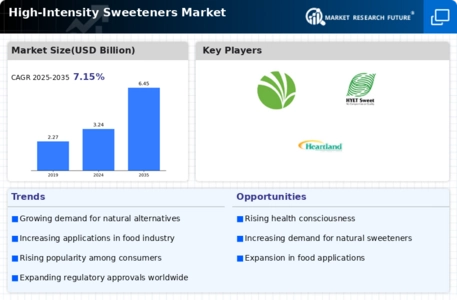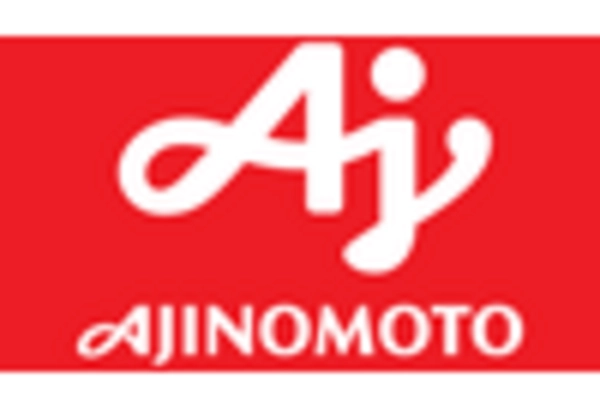Expansion of the Food Service Sector
The expansion of the food service sector is a crucial driver for the High-Intensity Sweeteners Market. As dining establishments increasingly seek to offer healthier menu options, the incorporation of high-intensity sweeteners has become a strategic focus. Restaurants and cafes are adapting their offerings to include low-calorie beverages and desserts, catering to the growing number of health-conscious patrons. This trend is supported by Market Research Future indicating that a significant portion of consumers actively seeks out low-sugar options when dining out. Consequently, the food service sector's growth is likely to propel the demand for high-intensity sweeteners, as establishments strive to meet evolving consumer preferences.
Innovation in Food and Beverage Products
Innovation within the food and beverage sector is a significant catalyst for the High-Intensity Sweeteners Market. Companies are increasingly exploring novel formulations that incorporate high-intensity sweeteners to enhance flavor profiles while reducing caloric content. This trend is particularly pronounced in the development of functional foods and beverages, where the integration of these sweeteners can provide added health benefits. For instance, the introduction of new soft drink variants that utilize high-intensity sweeteners has been met with positive consumer reception, indicating a shift towards healthier options. The market is expected to witness a continuous influx of innovative products, further driving the demand for high-intensity sweeteners.
Regulatory Support for Sugar Alternatives
Regulatory frameworks that support the use of sugar alternatives are likely to bolster the High-Intensity Sweeteners Market. Various health organizations and government bodies have recognized the potential benefits of high-intensity sweeteners in combating obesity and related health issues. As a result, there has been a push for policies that encourage the use of these sweeteners in food products. For example, certain countries have implemented guidelines that promote the reduction of sugar intake, thereby creating a favorable environment for high-intensity sweeteners. This regulatory support not only enhances consumer confidence but also incentivizes manufacturers to adopt these alternatives, contributing to market growth.
Rising Demand for Natural and Organic Products
The rising consumer preference for natural and organic products is influencing the High-Intensity Sweeteners Market. As consumers become more discerning about ingredient sourcing, there is a notable shift towards sweeteners derived from natural sources. This trend is reflected in the increasing popularity of stevia and monk fruit extracts, which are perceived as healthier alternatives to synthetic sweeteners. Market data suggests that the demand for natural high-intensity sweeteners is expected to grow significantly, driven by consumer desire for transparency and clean labeling. Manufacturers are responding by reformulating products to include these natural sweeteners, thereby aligning with consumer expectations and enhancing market competitiveness.
Health Awareness and Demand for Low-Calorie Options
The increasing awareness regarding health and wellness among consumers appears to be a primary driver for the High-Intensity Sweeteners Market. As individuals become more conscious of their dietary choices, the demand for low-calorie and sugar-free products has surged. According to recent data, the market for low-calorie sweeteners is projected to grow at a compound annual growth rate of approximately 5.5% over the next few years. This trend is particularly evident in the beverage sector, where consumers are actively seeking alternatives to traditional sugars. Consequently, manufacturers are innovating and reformulating products to incorporate high-intensity sweeteners, thereby catering to the evolving preferences of health-conscious consumers.

















Leave a Comment